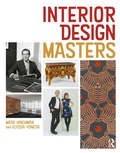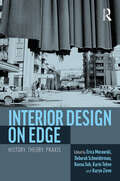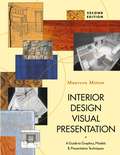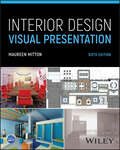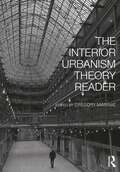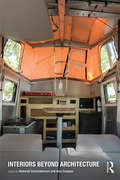- Table View
- List View
Interior Design is Not Decoration And Other Ideas: Explore the world of interior design all around you in 100 illustrated entries
by Catherine Anderson Stephanie TravisAn inspiring book exploring all aspects of interior design in 100 engaging and beautifully illustrated entries.Interior design is not about paint colors and accent cushions. It is an important practice that affects all our lives. This entertaining book explores the world of interior design with a snappy set of 100 entries, all explaining what interior design is in an attractive format. The wide range of topics covered just proves that interiors are an integral part of our lived experience. The book will appeal to students, professionals, and anyone interested in the fascinating subject of what surrounds us.Contents: media and culture psychology concepts space project types materials environment and wellbeing technical issues the profession
Interior Design Masters
by Mark Hinchman Elyssa YonedaInterior Design Masters contains 300 biographical entries of people who have significantly impacted design. They are the people, historical and contemporary, that students and practitioners should know. Coverage starts in the late Renaissance, with a focus on the twentieth and twenty-first centuries. The book has five sections, with the entries alphabetical in each, so it can serve as a history textbook and a reference guide. The seventeeth- and eighteenth-century section covers figures from Thomas Chippendale to Horace Walpole. The nineteenth-century section includes William Morris and Candace Wheeler. The early twentieth-century section presents modernism’s design heroes, including Marcel Breuer, Eileen Gray, and Gilbert Rohde. The post-World War II designers range from Madeleine Castaing to Raymond Loewy. The final contemporary section includes Ron Arad and the Bouroullec brothers. These are the canonical figures who belong to any design history. The book also contains less well-known figures who deserve attention, such as Betty Joel, the British art deco furniture designer; Paul Veysseyre, the Frenchman active in China in the 1930s; and more recently Lanzavecchia-Wai, the Italian-Singaporean duo whose work ranges from health care to helicopters. Global in its coverage, the book is richly illustrated with over 600 black-and-white and color photographs.
Interior Design Masters
by Mark Hinchman Elyssa YonedaInterior Design Masters contains 300 biographical entries of people who have significantly impacted design. They are the people, historical and contemporary, that students and practitioners should know. Coverage starts in the late Renaissance, with a focus on the twentieth and twenty-first centuries. The book has five sections, with the entries alphabetical in each, so it can serve as a history textbook and a reference guide. The seventeeth- and eighteenth-century section covers figures from Thomas Chippendale to Horace Walpole. The nineteenth-century section includes William Morris and Candace Wheeler. The early twentieth-century section presents modernism’s design heroes, including Marcel Breuer, Eileen Gray, and Gilbert Rohde. The post-World War II designers range from Madeleine Castaing to Raymond Loewy. The final contemporary section includes Ron Arad and the Bouroullec brothers. These are the canonical figures who belong to any design history. The book also contains less well-known figures who deserve attention, such as Betty Joel, the British art deco furniture designer; Paul Veysseyre, the Frenchman active in China in the 1930s; and more recently Lanzavecchia-Wai, the Italian-Singaporean duo whose work ranges from health care to helicopters. Global in its coverage, the book is richly illustrated with over 600 black-and-white and color photographs.
Interior Design Materials and Specifications: - with STUDIO
by Lisa GodseyThis complete guide to the selection of materials for interiors has been updated to reflect the most recent materials on the market and contemporary awareness on industry movements like sustainability. Written from the viewpoint of the working designer, Interior Design Materials and Specifications, 4th Edition, describes each material's characteristics and teaches students how to evaluate, select, and specify materials, taking into account factors including code compliance, building standards, sustainability guidelines, human needs, and bidding processes. Students will learn how to communicate with suppliers and vendors to achieve the results they envision and how to avoid some of the pitfalls common to material selection and specification. New to this Edition:-Information on laminated materials has been dispersed and integrated into related materials chapters -Covers the most up-to-date information on smart and sustainable materials currently used in the industry -Includes new Case Studies that illustrate points made throughout chapters, based on real-life situations -New chapter "Looking Ahead" looks at material research for potential interior surfacing options STUDIO Features: -Study smarter with self quizzes featuring scored results and personalized study tips-Review concepts with flashcards of essential vocabulary Instructor Resources:-Instructor's Guide provides suggestions for planning the course and using the text in the classroom, supplemental assignments, and lecture notes -PowerPoint® presentations include images from the book and provide a framework for lecture and discussion
Interior Design on Edge: History, Theory, Praxis
by Erica Morawski Deborah Schneiderman Keena Suh Karin Tehve Karyn ZieveInterior Design on Edge explores ways that interiors both constitute and upset our edges, whether physical, conceptual or psychological, imagined, implied, necessary or discriminatory.The essays in this volume explore these questions in history, theory, and praxis through a focus on different periods, cultures, and places. Interior Design on Edge showcases new scholarship that expands and contests traditional relationships between architecture, interiors, and the people that use and design them, provoking readers to consider the interior differently, moving beyond its traditional, architectural definition. Focusing on the concept of interiority considered in a wider sense, it draws on interdisciplinary modes of investigation and analysis and reflects the latest theoretical developments in the fields of interior design history and practice.With new research from both established and emerging authors, this volume will make a valuable contribution to the fields of Interior Design, Architecture, Art and Design History, Cultural History, Visual Culture Studies, and Urban Studies.
Interior Design on Edge: History, Theory, Praxis
Interior Design on Edge explores ways that interiors both constitute and upset our edges, whether physical, conceptual or psychological, imagined, implied, necessary or discriminatory.The essays in this volume explore these questions in history, theory, and praxis through a focus on different periods, cultures, and places. Interior Design on Edge showcases new scholarship that expands and contests traditional relationships between architecture, interiors, and the people that use and design them, provoking readers to consider the interior differently, moving beyond its traditional, architectural definition. Focusing on the concept of interiority considered in a wider sense, it draws on interdisciplinary modes of investigation and analysis and reflects the latest theoretical developments in the fields of interior design history and practice.With new research from both established and emerging authors, this volume will make a valuable contribution to the fields of Interior Design, Architecture, Art and Design History, Cultural History, Visual Culture Studies, and Urban Studies.
The Interior Design Productivity Toolbox: Checklists and Best Practices to Manage Your Workflow
by Phyllis HarbingerGet organized and streamline your workflow with this A-Z accountability system. Design is only part of an interior designer’s job—you’re also responsible for scheduling client meetings, conducting design surveys, creating drawings and specs, and overseeing installation. Multiply by the number of projects on your plate, and you have a recipe for overwhelming disorganization. The Interior Design Productivity Toolbox helps you juggle multiple projects with ease, with a comprehensive self-management system tailored to the needs of interior designers and decorators. Features include: Detailed checklists that highlight weak spots and warn against common pitfalls Covers residential design, contract design, specifications, and renovations Best practices for meetings, design surveys, drawings, specifications, and renovations Customizable online checklists for tracking every phase of your project Exclusive online budgeting tool for tracking product costs and associated expenses to share with your team and your clients If you need to get organized and get back to work, you need The Interior Design Productivity Toolbox.
The Interior Design Productivity Toolbox: Checklists and Best Practices to Manage Your Workflow
by Phyllis HarbingerGet organized and streamline your workflow with this A-Z accountability system. Design is only part of an interior designer’s job—you’re also responsible for scheduling client meetings, conducting design surveys, creating drawings and specs, and overseeing installation. Multiply by the number of projects on your plate, and you have a recipe for overwhelming disorganization. The Interior Design Productivity Toolbox helps you juggle multiple projects with ease, with a comprehensive self-management system tailored to the needs of interior designers and decorators. Features include: Detailed checklists that highlight weak spots and warn against common pitfalls Covers residential design, contract design, specifications, and renovations Best practices for meetings, design surveys, drawings, specifications, and renovations Customizable online checklists for tracking every phase of your project Exclusive online budgeting tool for tracking product costs and associated expenses to share with your team and your clients If you need to get organized and get back to work, you need The Interior Design Productivity Toolbox.
Interior Design Research Methods
by Lily B. RobinsonInterior Design Research Methods gives you the tools and skills needed to do research and analysis for human-centered interior design projects. The text develops your analytical skills and helps you transform scientific models into unique and innovative processes for design projects. You'll integrate information about external and internal influences on the research process, develop a research question and thesis, design a system of inquiry, and analyze, interpret, and present data. Updated case studies cover topics such as gender, design for vulnerable populations, and ethical considerations. Instructor's Guide includes test banks, sample syllabus, and supplemental assignments
Interior Design Student's Comprehensive Exam
by Lisa GodseyThe Interior Design Student's Comprehensive Exam is designed to take the mystery out of the National Council for Interior Design Qualification (NCIDQ) exam. Practice tests introduce students to the NCIDQ exam's multiple-choice format and wording, and design scenarios allow practice in a variety of residential, commercial, and mixed-use spaces. Note that these exercises are not directly endorsed by NCIDQ; however, the range and depth of the material is similar to recent professional exams, and students will gain the knowledge and flexibility required to pass the exam and jump-start their own careers.
Interior Design Visual Presentation: A Guide to Graphics, Models and Presentation Methods
by Maureen MittonA newly updated and comprehensive guide to all aspects of visual design From doing a quick sketch to producing a fully rendered model, the ability to create visual representations of designs is a critical skill for every designer. Interior Design Visual Presentation, Fifth Edition offers thorough coverage of interior design communication used throughout the design process, complete with a broad range of real-world examples. This fully updated handbook presents a full range of styles and techniques used for interior design visual communication, from hand drawing to 3D computer modeling. Its accessible, how-to approach guides you through a variety of methods for executing creative and successful design graphics, models, and presentations. Recognizing the ongoing proliferation of digital tools for visual representation, this edition provides the latest information on software used in presentation such as Photoshop, and SketchUp, and covers the integration of Revit, and AutoCAD generated content into design presentations. • Covers all aspects of visual design and presentation for interior designers • Includes color illustrations that feature a wide range of project types including residential, healthcare and public projects, designed to highlight step-by-step instructions • Provides a discussion of incorporation of 3D digital models into presentations including use in virtual reality, and expanded information on scale models including a discussion of 3D printing • Includes a companion website for instructors, featuring PowerPoint lecture slides and an instructor's manual From traditional to cutting-edge techniques, Interior Design Visual Presentation, Fifth Edition gives students and professionals alike the tools to give life to their design vision.
Interior Design Visual Presentation: A Guide to Graphics, Models and Presentation Methods
by Maureen MittonA newly updated and comprehensive guide to all aspects of visual design From doing a quick sketch to producing a fully rendered model, the ability to create visual representations of designs is a critical skill for every designer. Interior Design Visual Presentation, Fifth Edition offers thorough coverage of interior design communication used throughout the design process, complete with a broad range of real-world examples. This fully updated handbook presents a full range of styles and techniques used for interior design visual communication, from hand drawing to 3D computer modeling. Its accessible, how-to approach guides you through a variety of methods for executing creative and successful design graphics, models, and presentations. Recognizing the ongoing proliferation of digital tools for visual representation, this edition provides the latest information on software used in presentation such as Photoshop, and SketchUp, and covers the integration of Revit, and AutoCAD generated content into design presentations. • Covers all aspects of visual design and presentation for interior designers • Includes color illustrations that feature a wide range of project types including residential, healthcare and public projects, designed to highlight step-by-step instructions • Provides a discussion of incorporation of 3D digital models into presentations including use in virtual reality, and expanded information on scale models including a discussion of 3D printing • Includes a companion website for instructors, featuring PowerPoint lecture slides and an instructor's manual From traditional to cutting-edge techniques, Interior Design Visual Presentation, Fifth Edition gives students and professionals alike the tools to give life to their design vision.
Interior Design Visual Presentation: A Guide to Graphics, Models, and Presentation Techniques
by Maureen MittonThe new, updated edition of the successful book on interior design Interior Design Visual Presentation, Second Edition is fully revised to include the latest material on CAD, digital portfolios, resume preparation, and Web page design. It remains the only comprehensive guide to address the visual design and presentation needs of the interior designer, with coverage of design graphics, models, and presentation techniques in one complete volume. Approaches to the planning, layout, and design of interior spaces are presented through highly visual, step-by-step instructions, supplemented with more than forty pages of full-color illustrations, exercises at the end of each chapter, and dozens of new projects. With the serious designer in mind, it includes a diverse range of sample work, from student designers as well as well-known design firms such as Ellerbee and Beckett Architects and MS Architects.
Interior Design Visual Presentation
by Maureen MittonINTERIOR DESIGN VISUAL PRESENTATION Comprehensive guide covering all aspects of visual design, including planning, layout, and presentation. Interior Design Visual Presentation comprehensively addresses the visual design and presentation skills of the interior designer, featuring thorough, process-oriented coverage on the planning, layout, and the design of interior building spaces and guiding readers through techniques for executing creative and successful design graphics, models, and presentations. Color illustrations throughout the text feature a wide array of residential, institutional, and commercial settings designed to highlight step-by-step instructions. This newly updated and revised Sixth Edition includes a new overview of the design process for commercial design for students at all levels. Other revisions include new discussion of the impact of digital communication, examples of rendering materials in color, review of the latest tools for digital rendering, additional detail on creating hand drawings, and advanced technologies for physical model making, along with updated 3D modeling tutorials on Sketchup, Revit, Photoshop, and discussion of building information management (BIM) related to design intent and hand and digital rendering. Interior Design Visual Presentation includes information on: The design process and related graphics, covering diagrams and programming analysis graphics, programming matrices, schematic design, and design developmentParaline and perspective drawings, and sketching interior environments using photographs and perspective grid chartsMaterials, media, and tools involved in rendering by hand and constructing physical and digital scale modelsOrganization and composition guidelines when constructing boards, physical presentations, and digital presentationsGraphic design components, public speaking, and design communication when making a complete presentation Covering all aspects of visual design and presentation that interior designers need to know, Interior Design Visual Presentation is a highly accessible and valuable resource for students and professors in primarily first- and second-year courses in interior design degree programs, along with professional interior designers studying for the NCIDQ exam.
Interior Design Visual Presentation: A Guide To Graphics, Models, And Presentation Techniques
by Maureen MittonINTERIOR DESIGN VISUAL PRESENTATION Comprehensive guide covering all aspects of visual design, including planning, layout, and presentation. Interior Design Visual Presentation comprehensively addresses the visual design and presentation skills of the interior designer, featuring thorough, process-oriented coverage on the planning, layout, and the design of interior building spaces and guiding readers through techniques for executing creative and successful design graphics, models, and presentations. Color illustrations throughout the text feature a wide array of residential, institutional, and commercial settings designed to highlight step-by-step instructions. This newly updated and revised Sixth Edition includes a new overview of the design process for commercial design for students at all levels. Other revisions include new discussion of the impact of digital communication, examples of rendering materials in color, review of the latest tools for digital rendering, additional detail on creating hand drawings, and advanced technologies for physical model making, along with updated 3D modeling tutorials on Sketchup, Revit, Photoshop, and discussion of building information management (BIM) related to design intent and hand and digital rendering. Interior Design Visual Presentation includes information on: The design process and related graphics, covering diagrams and programming analysis graphics, programming matrices, schematic design, and design developmentParaline and perspective drawings, and sketching interior environments using photographs and perspective grid chartsMaterials, media, and tools involved in rendering by hand and constructing physical and digital scale modelsOrganization and composition guidelines when constructing boards, physical presentations, and digital presentationsGraphic design components, public speaking, and design communication when making a complete presentation Covering all aspects of visual design and presentation that interior designers need to know, Interior Design Visual Presentation is a highly accessible and valuable resource for students and professors in primarily first- and second-year courses in interior design degree programs, along with professional interior designers studying for the NCIDQ exam.
Interior Lighting for Designers
by Gary GordonThis revised edition of the successful primer thoroughly covers fundamentals of lighting design, and also serves as a handy reference for professional designers. The Fifth Edition is more comprehensive than ever, with new information on LED, energy efficiency, and other current issues. In addition, it includes more information for drawing ceiling floor plans and the application of designs to specific types of interiors projects. Considered a "key reference" for the Lighting Certified exam, no other text combines both technical and creative aspects of lighting design for beginners and novice designers.
Interior Lighting for Designers
by Gary GordonThis revised edition of the successful primer thoroughly covers fundamentals of lighting design, and also serves as a handy reference for professional designers. The Fifth Edition is more comprehensive than ever, with new information on LED, energy efficiency, and other current issues. In addition, it includes more information for drawing ceiling floor plans and the application of designs to specific types of interiors projects. Considered a "key reference" for the Lighting Certified exam, no other text combines both technical and creative aspects of lighting design for beginners and novice designers.
The Interior Plan: Concepts and Exercises - with STUDIO
by Roberto J. RengelThe Interior Plan is an introductory-level text introducing students to the process of interior design space planning. Topics include the design of effective spatial sequences, functional relationships among project parts, arrangement of furniture, planning effective circulation systems, making spaces accessible, and designing safe environments with efficient emergency egress systems. Exercises throughout the book facilitate learning by encouraging students to apply ideas and concepts immediately after reading about them. In the third edition, the author expands on the evolution of design ideas and how they affect interior environments and the people who use them, thinking sustainably, and how interior elevations and reflective ceilings affect the plan.New to This Edition -New and updated examples in residential, commercial, retail, and hospitality planning-New spreads addressing interior elevations, reflected ceiling plans, and interior planning for sustainability -New pedagogical features in every chapter, including learning objectives, discussion questions, and key termsInstructor Resources-Instructor's Guide provides suggestions for planning the course and using the text in the classroom, supplemental assignments, and lecture notes-PowerPoint® presentations include images from the book and provide a framework for lecture and discussionSTUDIO Features Include-Download examples of common design pitfalls and how to avoid them -Review concepts with flashcards of essential vocabulary and design strategies
Interior Style: Art Deco
by Jena Quinn Lucy DerbyshireArt Deco captures the vitality and modernity of the Jazz Age. From the refined interiors of 1920s Paris to the decadent and luxurious glamour of Hollywood, the bold geometry, simplicity of form and luxurious materials of Art Deco still feel distinctly modern today.With a historical overview and examples of stunning interiors, Interior Style: Art Deco explores the design essence of the era.With in-depth professional advice on how to use elements such as pattern, lighting, furniture and textiles, you will find the tools to recreate this sophisticated elegance in your own home.
Interior Style: Coastal
by Jena Quinn Lucy DerbyshireExpansive, sun-drenched spaces, unobstructed views to the outdoors and easy-going comfort - coastal design captures the spirit and escapism of seaside living. Illustrated with breathtaking interiors and inspirational showpiece homes, Interior Style: Coastal traces the evolution of the aesthetic from the white villas of the Riviera to the California Look of the USA's West Coast. With in-depth professional advice on how to use elements such as colour, texture and pattern, you will discover how to bring the tranquillity of coastal life into your home.
Interior Style: Maximalism
by Kristen BatemanThe extrovert of interior design and the definition of 'more is more', maximalism is an exuberant celebration of pattern, colour and texture that deliberately clash. Its roots lie in 1930s Hollywood Regency style, Rococo and Neoclassicism, as well as Greek, Egyptian and Asian styles.With a historical overview of the decor, and illustrated with examples of notable interiors and key elements of lighting, furniture, colour palette, texture and textile, the book offers practical advice on how to recreate the look in your own home.
The Interior Urbanism Theory Reader
by Gregory MarinicThe Interior Urbanism Theory Reader expands our understanding of urbanism, interiority, and publicness from a global perspective across time and cultures. From ancient origins to speculative futures, this book explores the rich complexities of interior urbanism as an interstitial socio-spatial condition. Employing an interdisciplinary lens, it examines the intersectional characteristics that define interior urbanism. Fifty chapters investigate the topic in relation to architecture, planning, urban design, interior architecture, interior design, archaeology, engineering, sociology, psychology, and geography. Individual essays reveal the historical, typological, and morphological origins of interior urbanism, as well as its diverse scales, occupancies, and atmospheres. The Interior Urbanism Theory Reader will appeal to scholars, practitioners, students, and enthusiasts of urbanism, architecture, planning, interiors, and the social sciences.
The Interior Urbanism Theory Reader
The Interior Urbanism Theory Reader expands our understanding of urbanism, interiority, and publicness from a global perspective across time and cultures. From ancient origins to speculative futures, this book explores the rich complexities of interior urbanism as an interstitial socio-spatial condition. Employing an interdisciplinary lens, it examines the intersectional characteristics that define interior urbanism. Fifty chapters investigate the topic in relation to architecture, planning, urban design, interior architecture, interior design, archaeology, engineering, sociology, psychology, and geography. Individual essays reveal the historical, typological, and morphological origins of interior urbanism, as well as its diverse scales, occupancies, and atmospheres. The Interior Urbanism Theory Reader will appeal to scholars, practitioners, students, and enthusiasts of urbanism, architecture, planning, interiors, and the social sciences.
Interiors Beyond Architecture
by Deborah Schneiderman Amy CamposInteriors Beyond Architecture proposes an expanded impact for interior design that transcends the inside of buildings,?analysing significant interiors that engage space outside of the disciplinary boundaries of architecture. It presents contemporary case studies from a historically nuanced and theoretically informed perspective, presenting a series of often-radical propositions about the nature of the interior itself. Internationally renowned contributors from the UK, USA and New Zealand present ten typologically specific chapters including: Interiors Formed with Nature, Adaptively Reused Structures, Mobile Interiors, Inhabitable art, Interiors for Display and On Display, Film Sets, Infrastructural Interiors, Interiors for Extreme Environments, Interior Landscapes, and Exterior Interiors.
Interiors Beyond Architecture
by Deborah Schneiderman Amy CamposInteriors Beyond Architecture proposes an expanded impact for interior design that transcends the inside of buildings,?analysing significant interiors that engage space outside of the disciplinary boundaries of architecture. It presents contemporary case studies from a historically nuanced and theoretically informed perspective, presenting a series of often-radical propositions about the nature of the interior itself. Internationally renowned contributors from the UK, USA and New Zealand present ten typologically specific chapters including: Interiors Formed with Nature, Adaptively Reused Structures, Mobile Interiors, Inhabitable art, Interiors for Display and On Display, Film Sets, Infrastructural Interiors, Interiors for Extreme Environments, Interior Landscapes, and Exterior Interiors.

